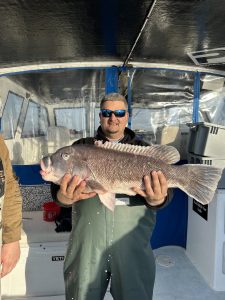Believe it or not, there is much to do outdoors in January. There are deer-hunting seasons, while the tog fishing has been good and should continue to be so. The long-range weather forecast is reasonable, so we can get outside without freezing to death.
There are a couple of charter and head boats running from Lewes, Ocean City and Indian River that can take you tog fishing. All have reported good catches at the end of 2022 and during the first few days of 2023. Some boats have their own regulations. They may have smaller bag limits or they may not allow you to keep big females. It is a good idea to check before booking a trip.
Tackle is another item to check before going on a boat. Most boats will have rental tackle, but it may not be the finest kind. I always take my own. I like a conventional reel filled with 60-pound braid and topped off with a shock leader of 40-pound fluorocarbon. I use an Albright knot to join the leader to the running line.
I tie my own tog rigs. I use 30- or 40-pound fluorocarbon with a perfection loop on one end and a double surgeon’s loop on the other. In between, I tie a dropper loop that is large enough to slip on a Virginia-style beak hook by running the loop through the eye of the hook and then running the hook back through the loop. The sinker goes on the surgeon’s loop, and the shock leader attaches to the perfection loop with a black Cross-Loc snap.
Some kind of crab will be your bait, and I have found the smaller pieces work best. A tog takes a bite of the bait, spits out the shell and swallows the meat in about one second. That is the time you have to set the hook once you feel the bite.
Setting the hook on a tog is a two-part operation. You set the hook by lifting the rod up as high as possible while cranking up as much line as you can. The idea is to set the hook and get the fish out of the structure as fast as possible. If you set the drag with Channellocks, it will make the job that much easier. You don’t want the tog to get back into the structure. If it does, you will lose your fish.
When you hook a big tog, there will be quite a battle as the fish tries to go down and you try to hold it in one place. It will be a test of your strength, your tackle and your knots. If everything holds together, you can begin to gain line, and while there will be smaller battles on the way up, the worst should be over.
January has both shotgun and muzzleloader deer seasons. Shotgun opens Jan. 14 and ends Jan. 22. Muzzleloader begins Jan. 23 and ends Jan. 29. That gives hunters two full weeks to fill their freezers.
Many hunters have leases on private land and that’s great. I had leases for many years, but now I have to hunt public land, and that is not ideal during the fall seasons. It is better in January when the hunting pressure is less.
You also have snow goose season that runs all through January. I personally have had very little luck with snows unless the ceiling was low or there was a thick ground fog.
There is always freshwater fishing. My New Castle County reporter Ed O’Donnell has been catching trout out of White Clay Creek, and in Sussex County, Loretta Smith has caught yellow perch on her fly rod.
Indian River Inlet is always open for tog fishing, and the beach is there for those of us who refuse to quit hoping for big striped bass.
Tog fishing at the inlet is not difficult. I use a 12-foot surf rod and the same rigs I use on a boat. I drop the rigs as close to 90 degrees from the tip of my rod as possible and use a 3-ounce bank sinker that seems to hold bottom without washing into a hole, never to been seen again. I sit in a folding chair and hold the line to detect the slightest bite. Once felt, the big rod is raised and the fish is pulled from the water.
You will need your fishing license and FIN (Fisherman Information Network) number.
All licenses are available online. If you are a surf fisherman, you may also get your surf-fishing permit online as well. Fish and Wildlife will have your licenses, while Parks will have your permits.
Credit: Source link






























